11 April 1857 Propulsion Alexander II approved the national emblem of Russia - the double-headed eagle
11 April 1857, the sovereign Alexander II approved the modified coat of arms of the Russian state - the double-headed eagle. Under Alexander Nikolayevich, the whole set of state emblems was approved - Big, Medium and Small, which were to symbolize the unity and power of the Russian Empire. These characters, without any changes existed until 1917 year. It should be noted that the emblem of the Russian state was modified under many rulers, any changes were made to it under Ivan Vasilyevich, Mikhail Fedorovich, Peter I, Paul I Petrovich, Alexander I, Nikolay I and Alexander III.
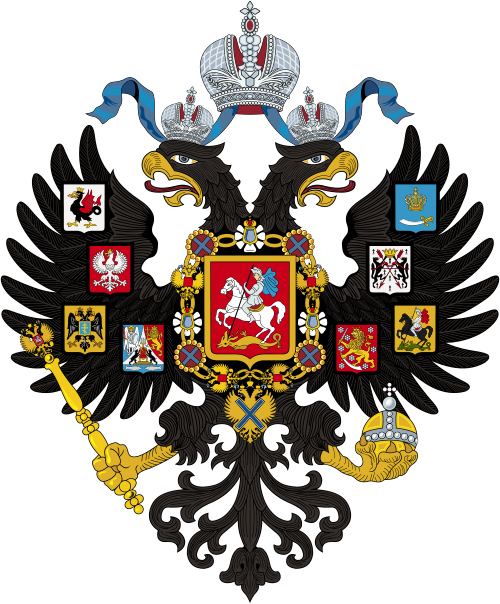
Small state emblem, 1857.
Double-headed eagle - the legacy of ancestors
The national emblem and color must always and invariably remain intact, as they bear a symbolic and historical value. It must be remembered that state symbols (the figurative expression of statehood, nation, its ideology) occupy an extremely important place in the life of the people, although this is usually invisible in everyday life.
One of the historical emblems of Russia-Russia is the two-headed eagle. In its antiquity and depth of meaning, it is second only to the rider striking a dragon serpent, which in a later, already Christian understanding, is known as George the Victorious. The rider symbolizes the thunder (Perun, Indra, Torah, etc.), which strikes the serpent (universal evil), it is one of the most important myths of the Indo-European language family.
The double-headed eagle (bird) is noted in a wide variety of cultures. In particular, in Sumerian and Indian mythologies. But it prevails in Indo-European cultures. It must be said that the many-headedness of various animals, mythical creatures is one of the features of Slavic mythology.
Especially often in antiquity there is a double-headed eagle in Asia Minor and the Balkan Peninsula. In Asia Minor, it is found since the times of the mighty power of 2 in the millennium BC. er - Hittite kingdom. Its founders were Indo-Europeans, whose ancestral home supposedly was the Balkan Peninsula. The Hittite Empire successfully competed with Egypt. The Hittites were among the first to master the secret smelting of iron, controlled all of Asia Minor and the straits from the Mediterranean to the Black Sea. The Hittite coat of arms was a two-headed eagle, which was preserved not only on standards, stone bas-reliefs, but also seals.
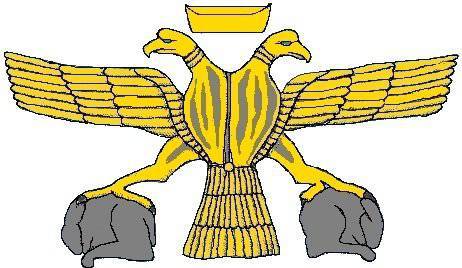
The symbol of the Hittite kingdom is a two-headed eagle. Reconstruction of reliefs from Hattusy.
Russian heraldists noted that the image of the two-headed eagle was known in ancient Pteria (city in Medes). It dates back to the turn of the century 7-6 centuries. BC er According to Xenophon, the Persians at about the same time served as an eagle symbol of supreme power. The symbol of the double-headed eagle was used by the Persian shahs from the Sassanid dynasty. In ancient times, the eagle and the lion were considered a symbol of royalty. In ancient Rome, Roman commanders had images of an eagle on their rods, it was a symbol of primacy over the troops. Later, the eagle became an exclusively imperial symbol, symbolizing supreme power. Western heraldists of the 17 century told the legend how the double-headed eagle became the state emblem of Rome. At the entrance of Julius Caesar to Rome, an eagle flew in the air above him, which attacked two kites, killed them, and threw them at the feet of the great commander. Surprised, Julius considered this to be a sign that predicts his victory and ordered to perpetuate it, adding a second head to the Roman eagle.
However, most likely, the appearance of the second head should be attributed to a later time, when the empire was divided into two parts - east and west. The body of the eagle was one, which meant common interests and origins, but with two heads facing west and east. Such an eagle was adopted as the emblem of the empire by Constantine the Great (ca. 272 - 337), or from other sources, Justinian I (483 - 565). Apparently, much later, the same symbolic significance was attached to the double-headed eagle of Austria-Hungary.
But the double-headed eagle was not an official symbol of the Byzantine Empire, as many believe. It was the emblem of the Paleologue dynasty, which ruled 1261 - 1453, and not the whole Byzantine state. After the start of the Crusades, the double-headed eagle appears in Western European heraldry. Thus, it is marked on the coins of Ludwig of Bavaria and the emblems of the burgraves of Würzburg and the Counts of Savoy. The German King and Holy Roman Emperor Frederick I Barbarossa (1122 - 1190) was the first to use the black double-headed eagle in his coat of arms. Frederick saw this symbol in Byzantium. Until 1180, the two-headed eagle was not marked on state seals, coins and regalia, as well as on the emperor's personal belongings. Earlier, the eagle was the symbol of the German rulers, but since the emperor Friedrich Barbarossa, both symbols were depicted on the coat of arms of the Holy Roman Empire. Only from the 15 century did the double-headed eagle become the state emblem of the Holy Roman Empire. In 19 - the beginning of 20 centuries, the double-headed eagle was the emblem of Austria-Hungary. In addition, in Serbia, the double-headed eagle became the emblem of the Nemanjic family. It was the ruling dynasty in 12-14 centuries.
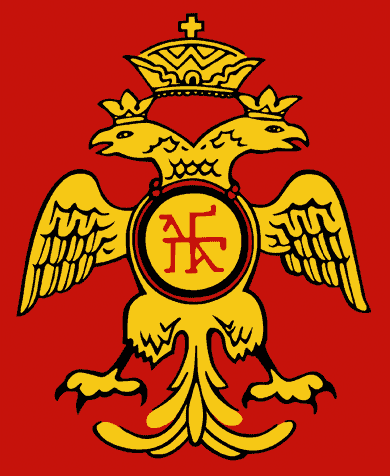
The emblem of the Palaeologus.
In Russia, the double-headed eagle was noted in the 13 century in the Chernigov principality, and in the 15 century - in the Tver and Moscow principalities. Had some walking double-headed eagle and the Golden Horde. Some researchers even claim that the double-headed eagle was the State Emblem of the Horde. But most historians do not support this version.
The seal of Ivan III Vasilyevich, which was inherited from Vasily II Vasilyevich, depicted a lion who tormented a snake (the lion was a symbol of the Vladimir principality). At the end of the 15th century, two new symbols appeared: the rider (rider), who was used in the Old Russian state and the two-headed eagle. The formal reason for using this symbol was the fact that Ivan III's wife was Sophia Paleolog, for whom the eagle was a generic sign. The emblem of the Paleologov was a black silhouette woven by black silk on a golden field. He was deprived of plastic and internal design, in fact, being a flat ornamental emblem.
According to another version, the double-headed eagle was known in Russia before the arrival of the Byzantine princess. For example, the “Chronicle of the Cathedral of Constance” by Ulrich von Riczenthal from 1416, the coat of arms of Russia with the image of a two-headed eagle was placed. The double-headed eagle was not a symbol of the Byzantine Empire, and the great Russian princes accepted it to emphasize their equality with the Western European monarchs, to be equal to the German emperor.
Sovereign Ivan III took the appearance of this emblem in the Russian kingdom very seriously. For the contemporaries of the Grand Duke, kinship between the Byzantine imperial dynasty and the house of Rurik was an act of great significance. In fact, Russia contested the rights of the strongest state of Western Europe - the Holy Roman Empire to this symbol. Moscow grand dukes began to rely successors of the Roman and Byzantine emperors. From the first half of the 16 century, the elder Filofei will formulate the concept “Moscow is the third Rome”. Ivan III the Great accepted this emblem not only as a dynastic sign of his wife, but as a heraldic symbol of the Russian state in the future. The first reliable use of the double-headed eagle as a state emblem symbol dates back to 1497, when the grand duke's certificate of land possession of princes was stamped on red wax. The front and back sides of the print carried images of a double-headed eagle and a rider hitting a serpent. At the same time, images of a gilded double-headed eagle appeared on the red field on the walls of the Faceted Chamber in the Kremlin.
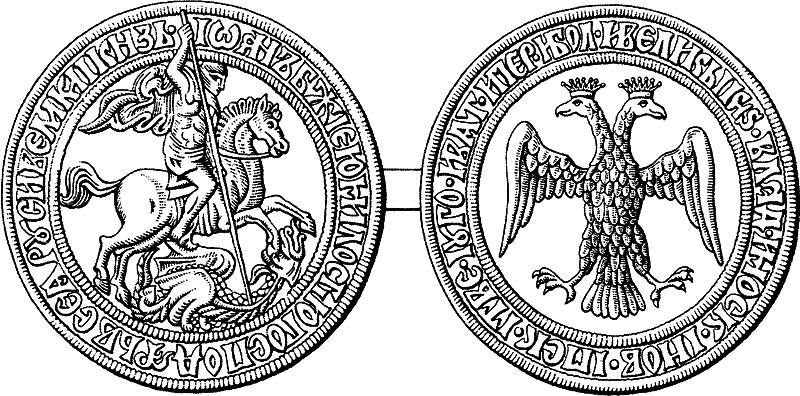
Seal of Ivan III, 1497 year.
The Byzantine eagle on Russian soil acquired new features, "Russified". In Russia, the previously simplified, lifeless graphic silhouette, filled with flesh, comes to life, ready to fly. This is a powerful, menacing bird. The eagle's breast covers the oldest, ancient Russian symbol - the Heavenly Warrior, the Winner of evil. The eagle was depicted in gold on a red field.
During the reign of Ivan IV, the double-headed eagle finally became the emblem of Russia. First, the emblem of the Russian kingdom was supplemented with a unicorn, and then a horse-serpent rider. Before the reign of Mikhail Romanov, there were two crowns above the heads of the eagle. Between them depicted a Russian eight-pointed cross - a symbol of Orthodoxy. Only in the large seal of Boris Godunov, the three heads of the eagle appear for the first time, they designated the Kazan, Astrakhan and Siberian kingdoms. Finally, the third crown appeared in 1625 year, it was introduced instead of the cross. Three crowns from this time meant the Holy Trinity, at a later time, from the end of 19 centuries began to be considered a symbol of the trinity of Eastern Slavs - Great Russians, Little Russians and Belarusians. Since the reign of Alexei Mikhailovich, the Russian eagle almost always holds the scepter and orb in his hands.
From the 15th to the mid-17th century, the Russian eagle was always depicted with wings lowered, which was determined by the Eastern heraldic tradition. Only on some seals of False Dmitry, apparently under Western influence, are the wings of an eagle raised. In addition, on one of the seals of False Dmitry I, the serpent-rider was turned to the right according to the Western European heraldic tradition.
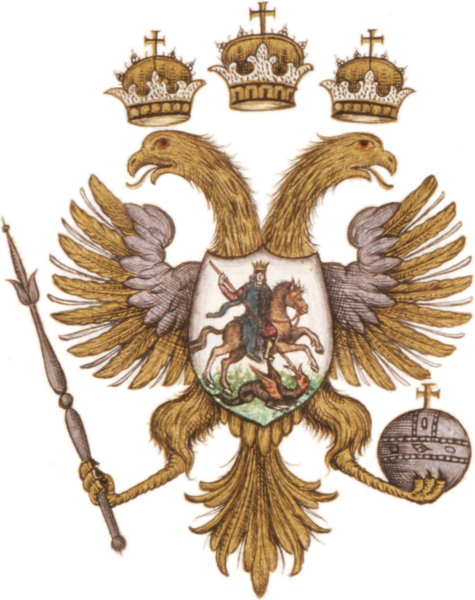
The coat of arms from the seal of Alexei Mikhailovich (1667 g.).
During the reign of Tsar Peter Alekseevich, with the approval of the Order of Sts. Andrew the First-Called, the Moscow coat of arms is almost always surrounded by a chain of the Order. The double-headed eagle itself. Under the influence of Western traditions, it becomes black. The rider from 1699 began to be officially called St. George. Under Empress Anna Ioannovna, a specially invited engraver, I. K. Gedlinger, prepared the State Seal for 1727, which will survive until the 1740 of the year with minor changes.
Emperor Pavel Petrovich, who became the grandmaster of the Order of Malta, in 1799, will introduce the Maltese cross on the chest into the Russian coat of arms, on which the Moscow coat of arms will be placed. If it is, an attempt will be made to develop and introduce the full coat of arms of the Russian Empire. By the year 1800 will be prepared a complex coat of arms, which will be 43 coat of arms. But before the death of Paul this emblem will not have time to take.
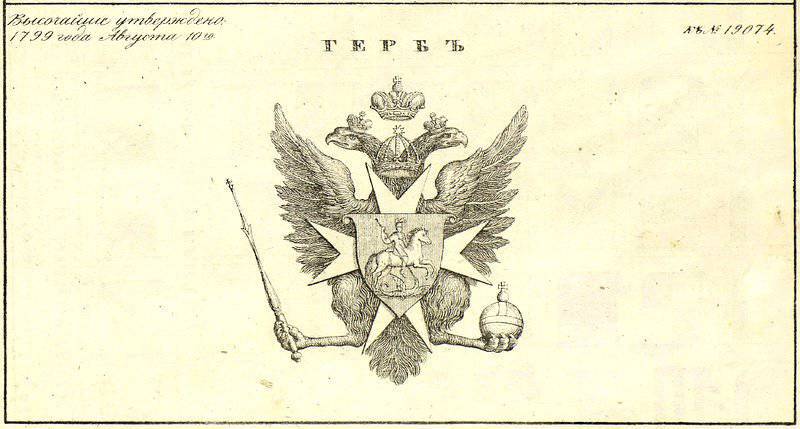
Coat of arms, approved by Paul I (1799 — 1801).
It must be said that before the reign of Alexander III, the Russian double-headed eagle was never exactly established by law. Therefore, the form, details, attributes and character changed in various reigns very easily and often significantly. So on the coins of the 18 century, apparently under the influence of Peter's antipathy towards Moscow, the eagle was depicted without the coat of arms of the old capital. The scepter and orb sometimes were replaced by a laurel branch, a sword and other emblems. By the end of the reign of Alexander I, the eagles were given not a heraldic, but a completely arbitrary form, which they borrowed in France. It was first placed on silverware made for the imperial house in France. This two-headed eagle had widely spread wings and held in its paws thunder arrows, a rod and a torch (in the right), a laurel crown (in the left) interlaced with ribbons. The dynastic St. Andrew’s chain disappeared, a heart-shaped, pointed shield with the Moscow coat of arms appeared on the eagle’s chest.
Under Nicholas I, there were two types of coat of arms. The simplified coat of arms had only basic elements. On the second on the wings title emblems: Kazan, Astrakhan, Siberian (on the right), Polish, Tauride and Finnish (on the left). The emblem itself is extremely monumental, harmoniously included in the new architectural style, known as the “Nikolaev Empire”. Wings like spread over Russia, as if protecting her. Heads are formidable and powerful.
Under the emperor Alexander II, a heraldic reform was carried out, its main author was Baron Koenet. There is a crown over the Moscow coat of arms, with St.. George is depicted in the image of a medieval knight in silver armor. The shape of an eagle is heraldic. On the small state emblem also appeared shields with the emblems of the territories within the Russian state. 11 April 1857 took a whole set of coats of arms - Large, Medium and Small State Emblems and other, only one hundred and ten drawings.
In the 1892 year, during the reign of Alexander III, an exact description of the state emblem appears in the Code of Laws of the Russian Empire. The St. Andrew chain will return to the eagle's chest. Black feathers will thicken the chest, necks and widely spread wings. Paws carry scepter and orb. The beaks of the eagles are ominously opened and the tongues are prostrated. The fiery gaze of fiery eyes faces east and west. The view of the eagle was solemn, impressive and formidable. On the wings were placed the arms. On the right: Kazan, Polish, Chersonesos of the Tauride kingdoms, united coat of arms of Kiev, Vladimir and Novgorod princedoms. On the left wing: the Astrakhan, Siberian, Georgian kingdoms, the Grand Duchy of Finland.
As a national symbol of the Russian people and Russian statehood, the two-headed eagle passed through three dynasties of the Russian autocrats — Rurikovich, Godunov and Romanov — without losing the significance of the supreme state emblem. The two-headed eagle also survived during the Provisional Government, when the swastika competed with it - a sign of the sun and a symbol of eternity. In 1993, the double-headed eagle returned to the coat of arms of the Russian state. Now, the double-headed eagle is a symbol of eternity of the Russian statehood, its continuity with the great empires of antiquity. Two heads of an eagle remind of the historical need for Russia-Russia to defend the frontiers in the West and the East. Three crowns over their heads, fastened with a single ribbon, symbolize the unity of the three parts of Russia (Russian civilization) - Great Russia, Little Russia and White Russia. Scepter and orb indicate the inviolability of the state foundations of our country. The eagle's chest, protected by a shield depicting a serpent horseman, points to the historical mission of the Russian people on Earth — the fight against evil in all its manifestations. Departure from this program leads to confusion and the collapse of the Russian statehood. Russia-Russia is the defender of the Truth on Earth.
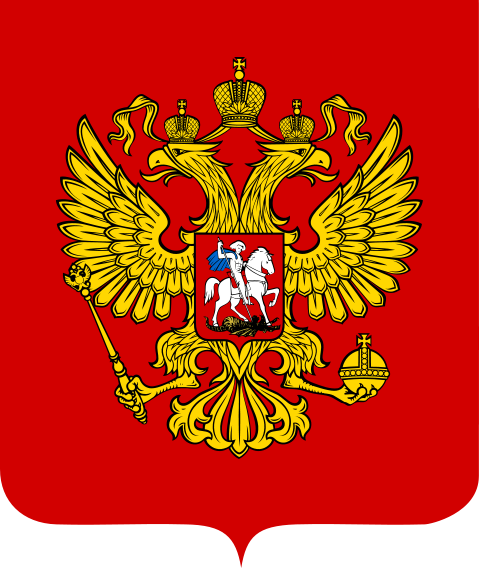
Modern Russian coat of arms.
Information